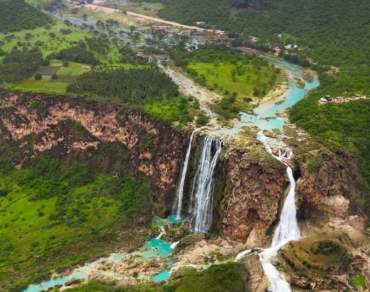My first sight of Wadi Shab left me speechless – an emerald oasis carved through Oman’s rugged mountains. This natural wonder ranks among the most beautiful hiking spots I’ve seen across the Middle East.
The magic Activities of Wadi Shab lies in its perfect blend of adventures. Hikers can walk past towering canyon walls, swim in crystal-clear pools, and explore hidden caves with waterfalls. My multiple visits to this natural gem taught me that the trip needs good planning and local insights to experience its beauty truly.
This detailed guide will help you plan every step of your Wadi Shab adventure. You’ll learn the best times to visit, how to reach the secret cave waterfall, and essential tips for your trip. Our guide serves both experienced hikers and curious travelers who want to experience this remarkable Omani destination.
Planning Your Wadi Shab Adventure
My many visits to Wadi Shab have taught me that good planning makes all the difference. These tested tips will give you the tools you need for an amazing adventure.
Best seasons and months to visit
The right timing is vital for your Wadi Shab visit. You’ll find the best conditions from October to April. The weather stays perfect for hiking and swimming during these months. Here’s how the seasons break down:
| Season |
Months |
Experience |
| Best Time |
Oct – Apr |
Pleasant temperatures, ideal conditions |
| Shoulder Season |
May, Sep |
Warmer but manageable |
| Challenging |
Jun – Aug |
Very hot, less comfortable |
The weekdays are your best bet for a visit. The place gets packed with tourists and locals on weekends (Friday-Saturday).
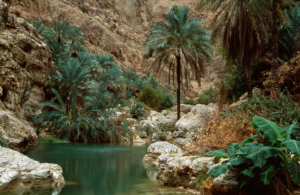 Weather considerations and water levels
Weather considerations and water levels
Our time at Wadi Shab Oman, shows that weather can make or break your trip. These are the conditions I always check before heading out:
- Water clarity (wait 5-6 days after rainfall to get the best views)
- Current weather forecast (skip the trip if rain shows up in the forecast)
- Water levels (local guides can tell you the current situation)
Essential gear and equipment checklist
Here’s my list of must-have items based on our adventures:
-
- Water shoes (you’ll need these for slippery rocks)
-
- Swimming attire (with modest cover-up)
-
- At least 2 liters of water per person
Modest dress is important outside swimming areas. Quick-dry shorts and a t-shirt over swimming gear work great. A waterproof camera or phone case will help capture those beautiful cave waterfall moments if you love photography like me.
Getting to Wadi Shab
The adventure starts before you even reach this natural wonder! After several trips to Wadi Shab, I can share the quickest ways to reach this hidden gem.
Transportation options from major cities
The route to Wadi Shab is easy to navigate, but your choices depend on where you start. Here’s what works best based on my experience:
| Starting Point |
Travel Time |
Best Option |
| Muscat |
1.5-2 hours |
Self-Drive/Tour |
| Sur |
40 minutes |
Self-drive only |
A rental car from Muscat gives you the most freedom to explore. Just follow Route 17 south until you see the Wadi Shab sign.
Parking and entrance details
The parking area sits right under the highway bridge. You’ll notice it right away when you turn off the main road. Here’s what to expect:
- Free parking (spaces fill up fast)
- Clean restroom facilities
- Small restaurant
- Local goats wandering around (keep those car doors shut!)
A helpful tip: Getting there by 7:30 AM helps you grab a parking spot and avoid the crowds, especially in peak season.
Boat crossing information and costs
A quick boat ride across the wide river kicks off your Wadi Shab Oman adventure. The essential details:
Boats run from 8 AM to 5 PM daily, and the crossing takes just 2-3 minutes. Bring 1 OMR per person in cash for both ways. Some people try wading across when water levels drop, but the boat remains your safest and most convenient option.
Remember to check the final boat timing for your return trip – I learned this lesson the hard way! The boatmen usually post this information, but it’s best to double-check during your first crossing.
The Hiking Experience
The towering canyon walls of Wadi Shab frame the path ahead like nature’s own gateway to adventure. This sight never fails to amaze me as I stand at the trailhead after crossing by boat.
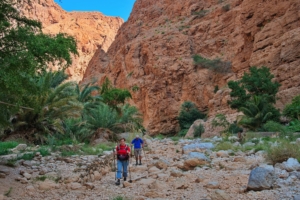 Trail difficulty and terrain types
Trail difficulty and terrain types
The 2.5-kilometer trail (each way) offers an interesting mix of terrains. Many online guides call it challenging, but most hikers would find it moderate. Here’s what you’ll see:
| Trail Section |
Terrain Type |
Difficulty |
| First 1km |
Flat concrete & dirt path |
Easy |
| Middle section |
Canyon wall traverse |
Moderate |
| Final stretch |
Boulder hopping & water crossings |
Moderate-challenging |
The trail rises gently with just 85 meters elevation gain, which suits most fitness levels. The real challenge lies not in the climb but in moving across slippery rocks, particularly near the end.
Key landmarks and photo opportunities
As someone who loves photography, I’ve found some amazing spots that capture Wadi Shab Oman’s true essence:
- The Canyon Balcony – About 1km in, where the path rises above the wadi
- Ancient Falaj System – Traditional irrigation channels still in use
- Emerald Pools – Crystal-clear waters against golden canyon walls
- The Keyhole – The narrow entrance to the famous cave
Early morning light creates the most stunning shots as shadows play across the canyon walls. The first pool area shows off the wadi’s most vibrant colors, so I keep my camera ready there.
Navigation tips and marked routes
The trail looks intimidating at first glance, but following it is straightforward. Yellow and black arrows painted on rocks mark the way, though some might not catch your eye immediately. These guidelines have served me well:
Shiny rocks point to frequently used paths. The ancient falaj system runs along the left side – that’s your best guide. If the path seems unclear, stop and look for painted arrows on nearby rocks. Other hikers are usually around to point you in the right direction.
The boulder field section, about two-thirds into the hike, needs extra attention. The best approach is to take it slow and stick to worn paths rather than creating new routes.
Swimming and Cave Exploration
The inviting pools of Wadi Shab look tempting after a tough hike. Experience has taught me that swimming here needs good preparation and respect for the water’s strength.
Safety guidelines for swimming sections
My many visits to these waters have shown that swimming ability is vital. The wadi has three main pools, each with its distinct personality:
| Pool |
Depth |
Swimming Difficulty |
| First Pool |
Shallow-Medium |
Beginner-Friendly |
| Second Pool |
Medium-Deep |
Intermediate |
| Third Pool |
Very Deep |
Advanced |
A word to fellow travelers: stay in the first pool or bring a life jacket if you’re not confident in deep water. The water stays surprisingly warm (around 30°C), which makes longer swims comfortable.
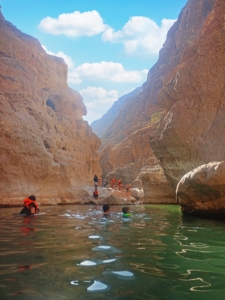 Accessing the hidden waterfall cave
Accessing the hidden waterfall cave
The true gem of Wadi Shab Oman, waits beyond the third pool – a hidden cave with a captivating waterfall. Getting there means you need to:
- Be able to swim continuously for at least 10 minutes
- Guide yourself through a narrow keyhole entrance (about 3 meters long)
- Tread water inside the cave (you won’t find standing space)
The slight current from the waterfall poses more challenges than the swim itself. You’ll need to turn sideways at the cave entrance and might have to submerge briefly depending on water levels. The reward comes when sunlight streams through the cave opening, creating a magical atmosphere that makes the trip worth every effort.
Tips for underwater photography
After one ruined camera and nearly losing another, I’ve become skilled at capturing Wadi Shab’s underwater beauty. Here’s what I use:
-
- Waterproof camera/phone case with wrist strap
-
- GoPro or a similar action camera
-
- Floating handle attachment
The cave’s unique lighting creates amazing photo opportunities. Midday brings the best natural lighting as sun rays pierce through the cave’s opening. Never risk your safety for a photo – I’ve watched too many cameras sink into deep pools while their owners tried tricky shots.
Make sure to secure your camera gear before entering the keyhole passage. The deep pools have swallowed countless devices, and local divers have found that recovery is almost impossible.
Cultural and Natural Significance
Each visit to Wadi Shab reminds me how this natural wonder reveals a story that spans millions of years. My appreciation for this Omani treasure grows deeper as I learn more about its origins and importance.
Geological formation of the wadi
The canyon shows how water has carved this magnificent gorge in the Eastern Hajar Mountains. Water erosion has shaped what geologists call karst topography over thousands of years. The massive cliffs stretch up to 1,500 meters and consist of Jurassic and Cretaceous marine sedimentary rocks that reveal ancient sea beds.
My explorations have revealed fascinating geological features:
- Layered limestone formations that showcase geological history over millennia
- Dramatic rock formations shaped by seasonal floods
- Natural terraces created by mineral deposits
- Crystal-clear pools from underground spring systems
Local traditions and customs
Wadi Shab Oman remains vital to local life, as I’ve discovered through my visits. The traditional Aflaj irrigation system’s parts date back 4,500 years and still work along the wadi’s edges. Local farmers maintain their terraced fields and grow dates, bananas, and papayas using these ancient water channels.
Omanis consider the wadi culturally significant because it serves as:
| Cultural Aspect |
Significance |
| Water Source |
Essential for traditional agriculture |
| Community Hub |
Gathering place for local families |
| Heritage Site |
Traditional farming techniques preserved |
| Cultural Symbol |
Representative of Omani resilience |
Flora and fauna spotting guide
The wadi’s wildlife diversity amazes me with each visit. Here’s my guide to spotting remarkable creatures that make Wadi Shab their home:
Birds to Watch For:
- Eagles and falcons soar above canyon walls
- Colorful kingfishers hunt for fish
- Herons wade in shallow pools
- Gray Francolins call distinctively
Notable Plant Life:
- Sodom’s Apple shrubs produce distinctive white latex
- Date palms line the waterways
- Desert-adapted plants show moisture-retaining features
- Electric blue flowers add color splashes
The Arabian Toad’s survival skills impress me as it burrows into wadi gravel during long droughts. The Jayakar’s Oman Lizard, native to these mountains, appears occasionally, though its camouflaged form blends with the rocks.
Nature’s resilience shows in the wadi’s biodiversity. Wild donkeys gallop past during my morning visits, while shepherds guide their goats through the terrain, keeping age-old traditions alive.
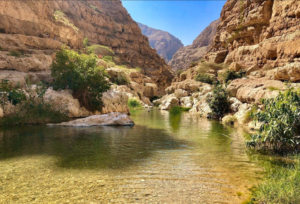 Conclusion
Conclusion
The activities of Wadi Shab show evidence of Oman’s raw natural beauty. Ancient geological forces have carved out an adventure playground that stands unique. My multiple visits have shown that this remarkable destination rewards prepared visitors who bring the right gear, time their visits well, and respect both natural wonders and local traditions.
The Wadi Shab experience delivers more than just a hike or swim. Each element creates an extraordinary adventure, from the boat crossing to the hidden waterfall cave. Sunlight pierces through limestone walls while rushing water echoes through caves. The cool, crystal-clear pools make every visit special and memorable.
This natural wonder explains why Oman’s wadis rank among the world’s most spectacular outdoor destinations. Wadi Shab’s combination of challenging trails, refreshing pools, and rich cultural heritage creates an adventure that stays with visitors long after they’ve dried off and headed home. Both experienced hikers and first-time visitors find something special here. Step into
Wadi Shab’s trip, a breathtaking history and beauty.
Book your place today! 
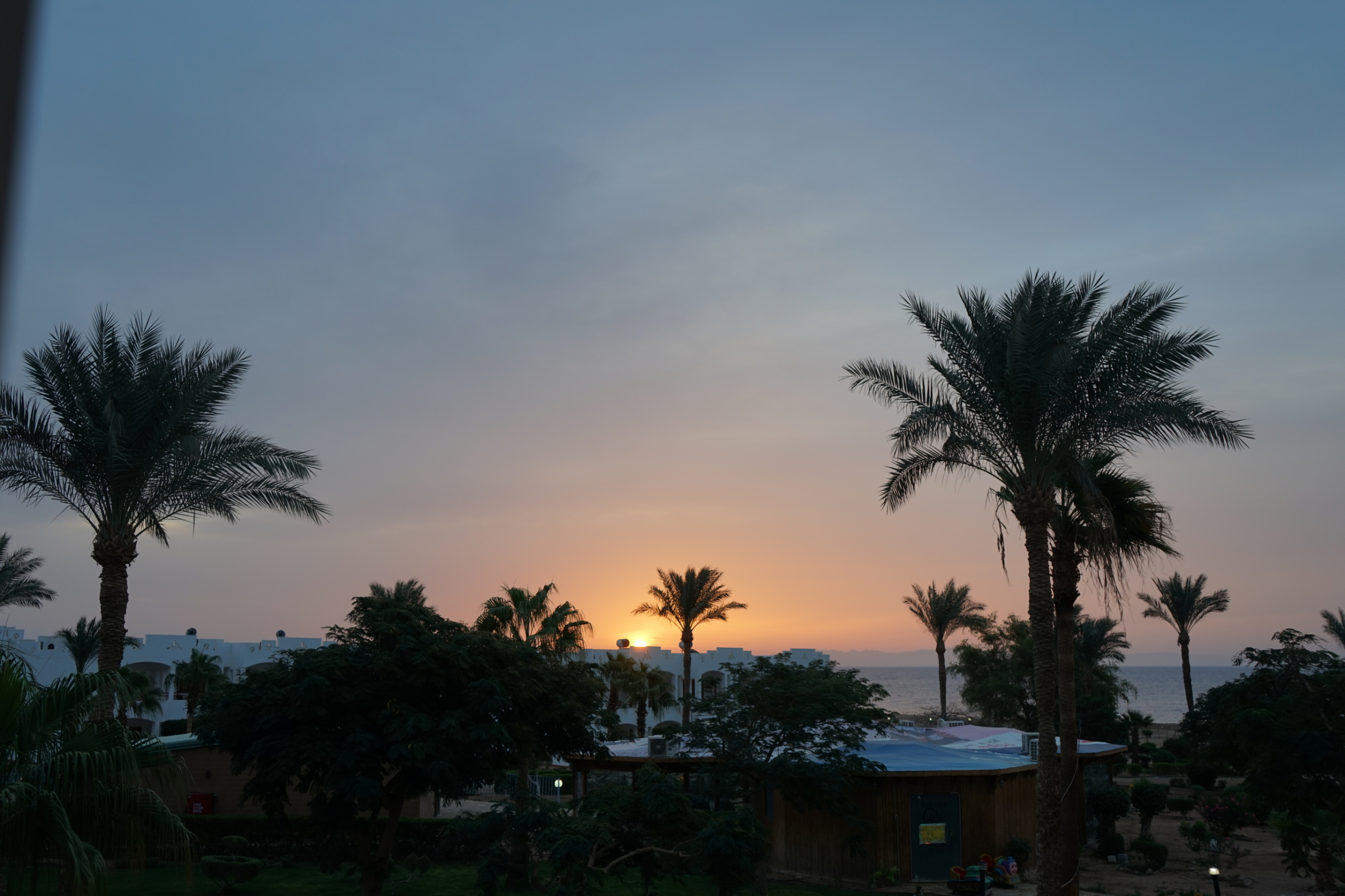
 Weather considerations and water levels
Our time at Wadi Shab Oman, shows that weather can make or break your trip. These are the conditions I always check before heading out:
Weather considerations and water levels
Our time at Wadi Shab Oman, shows that weather can make or break your trip. These are the conditions I always check before heading out:
 Trail difficulty and terrain types
The 2.5-kilometer trail (each way) offers an interesting mix of terrains. Many online guides call it challenging, but most hikers would find it moderate. Here’s what you’ll see:
Trail difficulty and terrain types
The 2.5-kilometer trail (each way) offers an interesting mix of terrains. Many online guides call it challenging, but most hikers would find it moderate. Here’s what you’ll see:
 Accessing the hidden waterfall cave
The true gem of Wadi Shab Oman, waits beyond the third pool – a hidden cave with a captivating waterfall. Getting there means you need to:
Accessing the hidden waterfall cave
The true gem of Wadi Shab Oman, waits beyond the third pool – a hidden cave with a captivating waterfall. Getting there means you need to:
 Conclusion
The activities of Wadi Shab show evidence of Oman’s raw natural beauty. Ancient geological forces have carved out an adventure playground that stands unique. My multiple visits have shown that this remarkable destination rewards prepared visitors who bring the right gear, time their visits well, and respect both natural wonders and local traditions.
The Wadi Shab experience delivers more than just a hike or swim. Each element creates an extraordinary adventure, from the boat crossing to the hidden waterfall cave. Sunlight pierces through limestone walls while rushing water echoes through caves. The cool, crystal-clear pools make every visit special and memorable.
This natural wonder explains why Oman’s wadis rank among the world’s most spectacular outdoor destinations. Wadi Shab’s combination of challenging trails, refreshing pools, and rich cultural heritage creates an adventure that stays with visitors long after they’ve dried off and headed home. Both experienced hikers and first-time visitors find something special here. Step into Wadi Shab’s trip, a breathtaking history and beauty. Book your place today!
Conclusion
The activities of Wadi Shab show evidence of Oman’s raw natural beauty. Ancient geological forces have carved out an adventure playground that stands unique. My multiple visits have shown that this remarkable destination rewards prepared visitors who bring the right gear, time their visits well, and respect both natural wonders and local traditions.
The Wadi Shab experience delivers more than just a hike or swim. Each element creates an extraordinary adventure, from the boat crossing to the hidden waterfall cave. Sunlight pierces through limestone walls while rushing water echoes through caves. The cool, crystal-clear pools make every visit special and memorable.
This natural wonder explains why Oman’s wadis rank among the world’s most spectacular outdoor destinations. Wadi Shab’s combination of challenging trails, refreshing pools, and rich cultural heritage creates an adventure that stays with visitors long after they’ve dried off and headed home. Both experienced hikers and first-time visitors find something special here. Step into Wadi Shab’s trip, a breathtaking history and beauty. Book your place today!  Weather considerations and water levels
Our time at Wadi Shab Oman, shows that weather can make or break your trip. These are the conditions I always check before heading out:
Weather considerations and water levels
Our time at Wadi Shab Oman, shows that weather can make or break your trip. These are the conditions I always check before heading out:
 Trail difficulty and terrain types
The 2.5-kilometer trail (each way) offers an interesting mix of terrains. Many online guides call it challenging, but most hikers would find it moderate. Here’s what you’ll see:
Trail difficulty and terrain types
The 2.5-kilometer trail (each way) offers an interesting mix of terrains. Many online guides call it challenging, but most hikers would find it moderate. Here’s what you’ll see:
 Accessing the hidden waterfall cave
The true gem of Wadi Shab Oman, waits beyond the third pool – a hidden cave with a captivating waterfall. Getting there means you need to:
Accessing the hidden waterfall cave
The true gem of Wadi Shab Oman, waits beyond the third pool – a hidden cave with a captivating waterfall. Getting there means you need to:
 Conclusion
The activities of Wadi Shab show evidence of Oman’s raw natural beauty. Ancient geological forces have carved out an adventure playground that stands unique. My multiple visits have shown that this remarkable destination rewards prepared visitors who bring the right gear, time their visits well, and respect both natural wonders and local traditions.
The Wadi Shab experience delivers more than just a hike or swim. Each element creates an extraordinary adventure, from the boat crossing to the hidden waterfall cave. Sunlight pierces through limestone walls while rushing water echoes through caves. The cool, crystal-clear pools make every visit special and memorable.
This natural wonder explains why Oman’s wadis rank among the world’s most spectacular outdoor destinations. Wadi Shab’s combination of challenging trails, refreshing pools, and rich cultural heritage creates an adventure that stays with visitors long after they’ve dried off and headed home. Both experienced hikers and first-time visitors find something special here. Step into Wadi Shab’s trip, a breathtaking history and beauty. Book your place today!
Conclusion
The activities of Wadi Shab show evidence of Oman’s raw natural beauty. Ancient geological forces have carved out an adventure playground that stands unique. My multiple visits have shown that this remarkable destination rewards prepared visitors who bring the right gear, time their visits well, and respect both natural wonders and local traditions.
The Wadi Shab experience delivers more than just a hike or swim. Each element creates an extraordinary adventure, from the boat crossing to the hidden waterfall cave. Sunlight pierces through limestone walls while rushing water echoes through caves. The cool, crystal-clear pools make every visit special and memorable.
This natural wonder explains why Oman’s wadis rank among the world’s most spectacular outdoor destinations. Wadi Shab’s combination of challenging trails, refreshing pools, and rich cultural heritage creates an adventure that stays with visitors long after they’ve dried off and headed home. Both experienced hikers and first-time visitors find something special here. Step into Wadi Shab’s trip, a breathtaking history and beauty. Book your place today! 